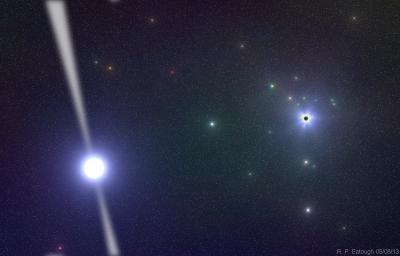Astronomers have discovered a pulsar at the center of our Milky Way and this magnetar - a pulsar with extremely high magnetic fields of the order of 100 million (108) Tesla, about 1,000 times stronger than the magnetic fields of ordinary neutron stars - and its extremely strong magnetic field enabled researchers to investigate the direct vicinity of the black hole at the heart of the galaxy.
They measured the strength of the magnetic field around this central source and were able to show that the latter is fed by magnetic fields. These control the inflow of mass into the black hole, also explaining the x-ray emissions of this gravity trap.
The discovery of a pulsar closely orbiting the candidate supermassive black hole at the center of the Milky Way, called Sagittarius A*, or Sgr A* in short, has been one of the main aims of pulsar astronomers for the last 20 years. Pulsars, those extremely precise cosmic clocks, could be used to measure the properties of space and time around this object, and to see if Einstein's theory of General Relativity could hold up to the strictest tests.
The newly found pulsar, labeled PSR J1745-2900, has an extremely high magnetic field 100,000 billion times the Earth's magnetic field. The emission from these objects is also known to be highly polarized. Measurements of the rotation of the plane of polarization caused by an external magnetic field (the Faraday effect) can be used to infer the strength of the magnetic field along the line-of-sight to the pulsar.

Artist's impression of PSR J1745-2900, a pulsar with a very high magnetic field ("magnetar") in direct vicinity of the central source of our Galaxy, a supermassive black hole of approximately 4 million times the mass of our sun. Measurements of the pulsar imply that a strong magnetic field exists in the vicinity around the black hole. Credit: MPIfR/Ralph Eatough.
Shortly after the announcement of a flaring X-ray source in the direction of the Galactic centere by NASA's Swift telescope, and the subsequent discovery of pulsations with a period of 3.76 seconds by NASA's NuSTAR telescope, a radio follow-up program was started at the Effelsberg radio observatory of the Max Planck Institute for Radio Astronomy (MPIfR).
"As soon as we heard about the discovery of regular pulsations with the NuSTAR telescope we pointed the Effelsberg 100-m dish in the direction of the Galactic center", says Ralph Eatough from MPIfR's Fundamental Physics Research department, the lead author of the study. "On our first attempt the pulsar was not clearly visible, but some pulsars are stubborn and require a few observations to be detected. The second time we looked, the pulsar had become very active in the radio band and was very bright. I could hardly believe that we had finally detected a pulsar in the Galactic center!"
Because this pulsar is so special, the research team spent a lot of effort to prove that it was a real object in deep space and not due to man-made radio interference created on Earth.
Additional observations were performed in parallel and subsequently with other radio telescopes around the world (Jodrell Bank, Very Large Array, Nançay). "We were too excited to sleep in between observations! We were calculating flux densities at 6 AM on Saturday morning and we could not believe that this magnetar had just turned on so bright," says Evan Keane from the Jodrell Bank Observatory.
Other collaborations worked at different telescopes (Australia Telescope/ATCA, Parkes and Green Bank Telescope). A research paper on the ATCA results by Shannon & Johnston appears in this week's issue of the British journal MNRAS.
"The Effelsberg radio telescope was built such that it could observe the Galactic centre. And 40 years later it detects the first radio pulsar there", explains Heino Falcke, professor at Radboud Universiteit Nijmegen. "Sometimes we have to be patient. It was a laborious effort, but finally we succeeded."
The magnetic field strength in the vicinity of the black hole at the centre of the Galaxy is an important property. The black hole is gradually swallowing its surroundings (mainly hot ionized gas) in a process of accretion. Magnetic fields caused by this in-falling gas can influence the structure and dynamics of the accretion flow, helping or even hindering the process. The new pulsar has allowed measurements of the strength of the magnetic field at the beginning of the accretion flow to the central black hole, indicating there is indeed a large-scale and strong magnetic field.

An ear in space: The 100-m Effelsberg radio telescope during regular observations of the Galactic Centre region for unidentified pulsars. The Galactic Centre is in the Sagittarius constellation, which is extremely close to the horizon in the southern direction, and is only visible for approximately 2 hours every day. Credit: MPIfR/Ralph Eatough
"In order to understand the properties of Sgr A*, we need to comprehend the accretion of gas into the black hole", says Michael Kramer, director at MPIfR and head of its Fundamental Physics research department. "However, up to now, the magnetization of the gas, which is a crucial parameter determining the structure of the accretion flow, remains unknown. Our study changes that by using the discovered pulsar to probe the strength of the magnetic field at the start of this accretion flow of gas into the central object."
References:
R.P. Eatough et al., A strong magnetic field around the supermassive black hole at the centre of the Galaxy Nature, August 14, 2013 (DOI: 10.1038/nature12499)
J. A. Kennea et al., Swift Discovery of a new soft gamma repeater, SGR J1745-29, near Sagittarius A* Astrophysical Journal Letters 770, L24, 2013 (http://arxiv.org/abs/1305.2128)
K. Mori et al., NuSTAR discovery of a 3.76-second transient magnetar near Sagittarius A*
Astrophysical Journal Letters 770, L23, 2013 (http://arxiv.org/abs/1305.1945)
R. M. Shannon, S. Johnston, Radio properties of the magnetar near Sagittarius A* from observations with the Australia Telescope Compact Array Monthly Not. Roy. Astron. Soc. (MNRAS) Letters, August 14, 2013 (http://de.arxiv.org/abs/1305.3036)






Comments